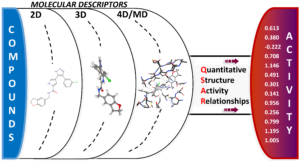Predictive Quantitative Structure–Activity Relationship (QSAR) modeling has become an essential methodology for rapidly assessing various properties of chemicals. The vast majority of these QSAR models utilize numerical descriptors derived from the two- and/or three-dimensional structures of molecules. However, the conformation-dependent characteristics of flexible molecules and their dynamic interactions with biological target(s) is/are not encoded by these descriptors, leading to limited prediction performances and reduced interpretability. 2D/3D QSAR models are successful for virtual screening, but typically suffer at lead optimization stages. That is why conformation-dependent 4D-QSAR modeling methods were developed two decades ago. However, these methods have always suffered from the associated computational cost. Recently, 4D-QSAR has been experiencing a significant come-back due to rapid advances in GPU-accelerated molecular dynamic simulations and modern machine learning techniques.
To continue reading this paper click here

